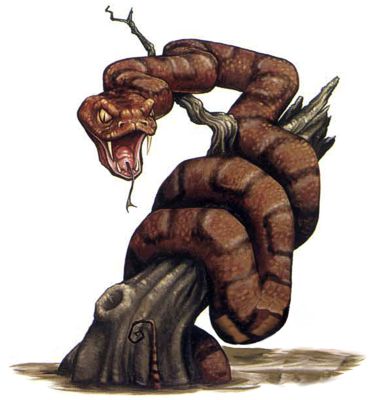

The Sword of Roele • Monstrous Compendium Annual, Volume Four

| Climate/Terrain: | Subtropical/Forest, marsh or subterranean |
|---|---|
| Frequency: | Uncommon |
| Organization: | Solitary |
| Activity Cycle: | Any |
| Diet: | Carnivore |
| Intelligence: | Low (5-7) |
| Treasure: | Nil |
| Alignment: | Neutral evil |
| No. Appearing: | 1 |
| Armor Class: | 3 |
| Movement: | 9, Cl 3 |
| Hit Dice: | 4+3 |
| THAC0: | 15 |
| No. of Attacks: | 1 |
| Damage/Attack: | Special |
| Special Attacks: | Constriction |
| Special Defenses: | Surprised only on a 1, displacement |
| Magic Resistance: | Nil |
| Size: | H (21’ long) |
| Morale: | Elite (14) |
| XP Value: | 1,400 |
The mahogany constrictor is a dangerous subtropical snake that uses both venom and constriction to bring down its prey. Its scales are a rich reddish-brown, with a spiral pattern of black and white scales running down its back.
Combat: The mahogany constrictor hunts in trees and on the ground, approaching its prey very slowly until ready to attack. Sometimes it will drop down and seize prey while remaining tightly wrapped around a sturdy branch, although it lacks the leverage to pull a man-sized creature into the trees.
Its constriction attack is strong enough to literally crush bones and rupture organs. As a result, its constriction damage increases each round it holds a victim in its coil. The first round the constriction attack is established, it inflicts 1d4 points of damage, and no further attack rolls are necessary. Constriction damage increases by 1d4 each round, to a maximum of 4d4; thus, 2d4 the second round, 3d4 the third round, and 4d4 points of damage per round thereafter.
If the prey is exceptionally large or strong, the snake will bite with its large fangs before constricting. Its venom is relatively dilute for such a large animal, but there is lots of it. Its poison has an onset time of 1d3 rounds, and then inflict 3d6 points of damage (half damage if a saving throw vs. poison is successful).
The snake bites or constricts in a round, but not both.
Habitat/Ecology: Mahogany constrictors live in deep jungles, coastal cypress swamps, and along forested riverbanks - anywhere there is both water and shelter.
